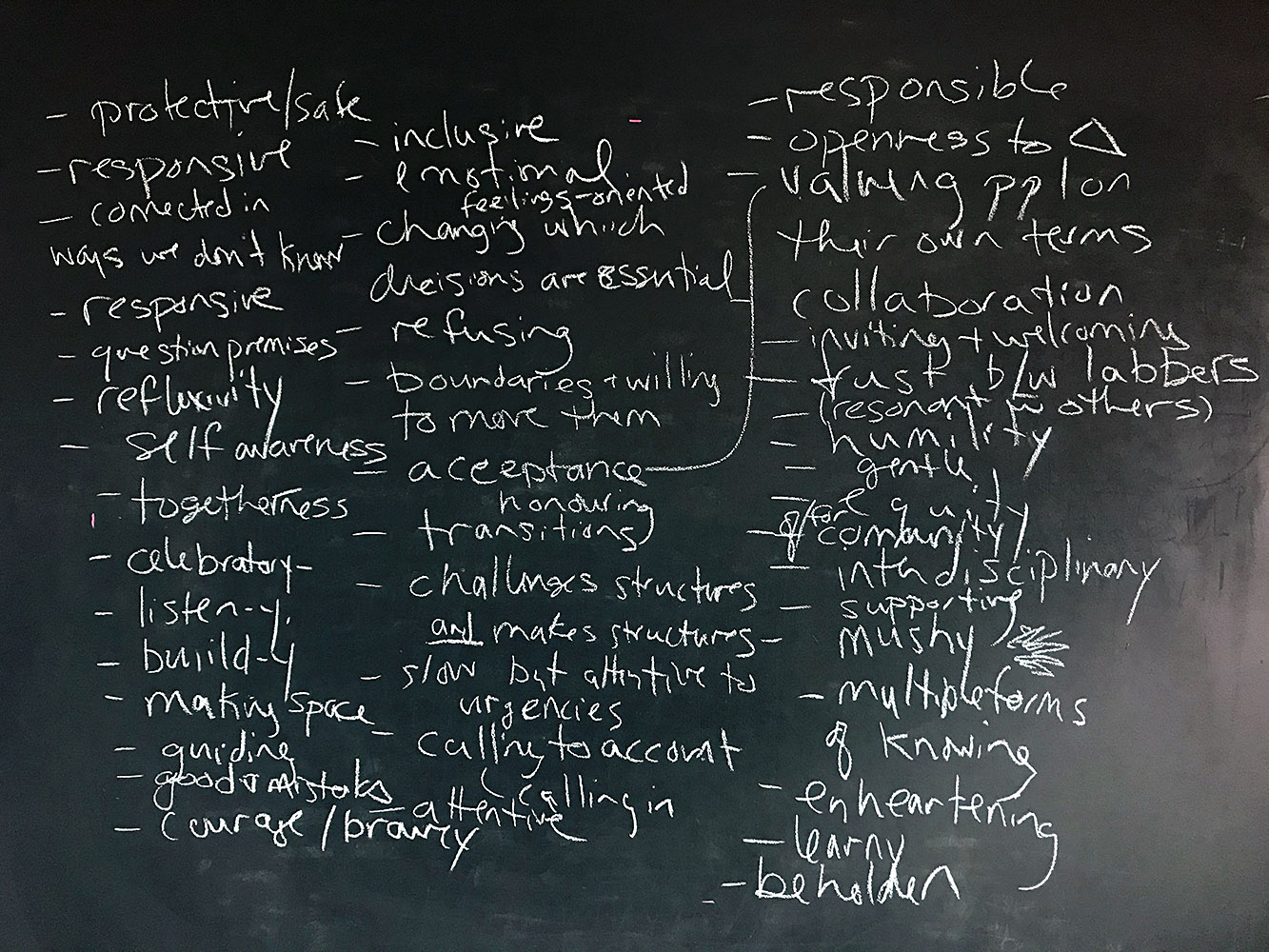CLEAR is dedicated to humility, accountability, and good land relations in everything we do, from hiring new members to choosing research questions. But how did we arrive at “humility, accountability, and good land relations”? Episode 2 of Laboratory Life: “Choosing our lab values” shows the process, taking the viewer through stages of storytelling, consensus, and deliberation.
Step 1: Tell stories
To start understanding what our lab culture and practices already value, we tell stories. This allows us to focus on values we already have and enact, rather than reaching for the ‘ol “equity, diversity and inclusion” that many institutional value statements talk about and likely support on paper, but don’t necessarily have the capacity to enact. A core part of building a shared lab culture is that is feasible.
The prompt we use to tell stories is: Talk about a time when something happened that made you really glad to be here. Stories with people doing things in place are better than statements about what you value. As each person tells their story, the facilitator (or note takers) write down the values they hear within the story.

Step 2: Cluster values
In this stage, the list of values gets shortened by grouping them together. Some of the values on the list will be similar and/or add necessary context to one another. For example, reflexivity, self-awareness, honouring transitions, and questioning premises are similar values that might belong together in a cluster called “reflexivity.” Or perhaps when stories were being told, “beholden” specifically refers to a way of being attentive, so those two values get clustered.
There are many ways to do this step. You can physically write values on cards of paper and move them around a table as a group. You can draw lines that link values together. One value can be repeated in several groups, and sometimes values just sort of hang out on their own.
Step 3: Rank the clusters
The guiding values in a collective or group have to be just that–guiding. This means that there can’t be 17 of them. Indeed, some of the hard decisions in a collective are about such conflicts, say when one option is more prestigious and can help multiple careers, but the other option is more humble and matters more to only one person’s quality of life. What kind of a lab are you? Which is the better decision, based on your values? That means you need to know which value(s) guide the lab. CLEAR has 3 main values (that are highly related), but you can also do just one.
There are many ways to rank things as a collective. You can use a dotmocracy or dot-voting (or the more private version, feedback frames). CLEAR tends to use two variations on dot-voting called passion voting and rank voting. You can use a selection chart. The method depends on what works best for your group to ensure all voices are heard and you are able to deal with existing power dynamics in your group (which are always there, even if everyone loves each other).
Step 4: Articulate the core values
So now you have 1-3 core values! Congratulations! But what does the value mean? For instance, if you have “Respect” as a core value, that can be interpreted to mean “give someone space to be different when they are different than you” but it can also mean “follow the rules.” Spend some time with the group talking about the core value(s) and why they were ranked so highly.
Here’s an example of what CLEAR wrote about our two main values: “Our core value, humility (understanding we are always connected to others, both human and non-human, in different and uneven ways) requires accountability (the actions that enact gratitude and responsibilities for and to those connections)” (CLEAR, 2021).
Step 5: Enacting those values, over and over and over…
The purpose of articulating common values is that they guide the decisions and actions of the group. Since we started the process by telling stories, your group likely already does some of this. Brain storm a list. How does your group already do things in a humble/respectful/self-reflexive way? What are other things you could do to strengthen that?
Here are some examples from how CLEAR foregrounds accountability in our lab work:
- “We only collect data in places where we have been invited. For example, it took Dr. Liboiron three years to do work in Labrador, as it took that long to gain a good reputation and receive explicit invitations for doing work in/with different groups and Lands.” (CLEAR 2021)
- “We have a mandatory community peer review process when we study contamination, where we report our findings back to the communities we sample from before we publish to ensure we are representing them in a way that is in alignment with their needs and goals so they have the opportunity to change, support, or refuse our work (see Community peer review in Part two of the lab book for details)” (CLEAR 2021)
- “We include metadata in our data sets to be accountable to those who follow us.” (CLEAR 2021)
- “We learn to step up to advocate for another person’s work or ideas if they are quiet, modest, or absent, and to step back if we have taken up more space than others during a conversation. Sometimes we have to remind one another to step up or step back.” (CLEAR 2021)
References
- CLEAR. (2021). CLEAR Lab Book: A living manual of our values, guidelines, and protocols, V.03. St. John’s, NL: Civic Laboratory for Environmental Action Research, Memorial University.

3 Comments
Comments are closed.